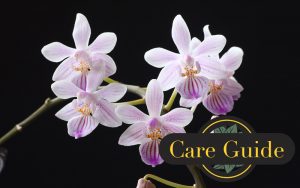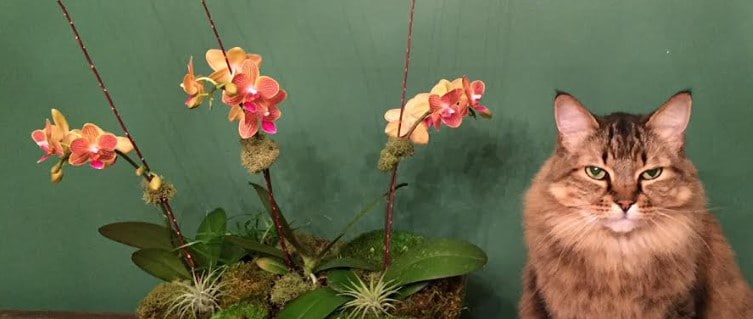
Moth Orchid Care
Click Here to view or download this guide as a PDF.
It’s no wonder Moth Orchids (Phalaenopsis) are the most popular orchid in the U.S. As a houseplant, they provide sprays of beautiful blooms that last for weeks, sometimes months, in colors from pure white, yellows, oranges, and pinks to multihued blossoms. They also reward their owner by reliably reblooming. Since the home environment is very similar to what they need, moth orchids will thrive with little special care.
Light: Phalaenopsis thrive in the soft light of most homes. This can be an east window, or a west or south window if positioned several feet from the window and not in direct sun. If using a light meter, recommended readings would be 10,000 to 15,000 Lux or 1000 to 1500 Footcandles.
Water: In nature, Phalaenopsis live epiphytically (on trees) in tropical rain forests, so the only soil they would experience would be from decaying vegetation that has gathered around their roots up in the trees. When purchased, they are potted in a highly draining mix of bark, volcanic rock, and perhaps Perlite. They may also come potted in long fiber sphagnum moss. These media allow for the extreme drainage that the orchids require. The first time you water, make sure that your potted orchid drains well.
The most frequent watering mistake is overwatering. You can run tepid water through the pot for minutes or more during a watering (and experienced growers often do to make sure the media is thoroughly wetted) but then the media should be allowed to almost dry out before watering again. In an average home, Phalaenopsis will be watered about every week to 2 weeks, and the orchids potted in moss can probably go longer than those in bark. After you’ve watered your orchid, pick up the plant to get an idea of the weight of the pot. This is another way to help gauge when the plant is getting dry. Always be sure the pot is not standing in any water that has run off. Sometimes orchids are sold in pots inside other pots and this could lead to root rot if not watered properly.
Earlier the word tepid was used. Although you can find instructions to use ice cubes to water your orchid, this probably began as an answer to overwatering. Orchid societies do not recommend this and over time it would most likely be harmful to a warm climate plant. There is evidence that it may trigger a bloom cycle but constantly being triggered to bloom may also be detrimental.
Orchids are sensitive to salts so the best water to use is unsoftened tap water, clean rain or well water, distilled water used in combination with orchid fertilizer (since distillation removes all minerals), or reverse-osmosis filtered water. Allowing the water to run through the pot for several minutes will help flush any accumulated salts. Watering in the morning will lessen the likelihood of fungal problems.
Fertilization: It is best to feed orchids often, at a dilute rate. That said, they will do better with too little fertilizer than too much. You can apply 1/4 strength orchid food or 20-20-20 fertilizer with trace elements, at every watering.
Temperature: Normal indoor temperatures work well for Phalaenopsis. Night time temperatures should stay above 60° and day time can range from 70° to 85° or higher to 95° with higher humidity and air movement. Although these orchids benefit from air circulation, cold drafts or air from drying heat sources should be avoided.
Humidity: This is where our household environment and the preferred orchid environment can be the poorest match. The recommended humidity is 50 – 80% but orchids still seem to handle low ranges with little harm. To add humidity, you can elevate the pot on rocks in a tray of water so the orchid’s roots stay dry.
Potting: The best time to repot an orchid is right after flowering. Orchids should be repotted about every 2 years to replace media which has started to break down, usually not because the pot size needs to be increased. Use a porous mix like bark mix, hydroponic clay balls or long fiber sphagnum. Pot alternatives include plastic, clay, clay orchid pots (holes on sides), baskets, cork or wood slabs. Avoid the colorful glazed pots for direct contact with orchids as these sometimes contain metals which can be very harmful to them. To repot, remove all old media from the roots, trim soft or rotted roots and spread the remaining roots over a handful of medium in the bottom of the pot. Fill the pot with medium, working it among the roots until reaching the top of the roots.

